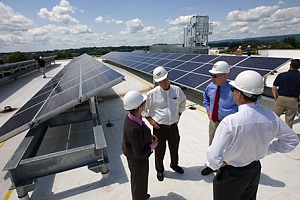PA program's funds drying up
 Hey Keystone Staters, want a good reason to go solar and do it now? How about a fat rebate check from the state? In May 2009, Pennsylvania offered up $100 million in rebates to homeowners and small businesses that install photovoltaic systems. But hurry up. Already nearly three quarters of the the program’s $100 million budget has been doled out. The state originally expected the Sunshine Solar Rebate Program to last for three to four years. But it looks like the money will be gone by early 2011. So it’s time to hop in your buggies and boogie on down to your local PV installer to get in on the action while it’s still available!
Hey Keystone Staters, want a good reason to go solar and do it now? How about a fat rebate check from the state? In May 2009, Pennsylvania offered up $100 million in rebates to homeowners and small businesses that install photovoltaic systems. But hurry up. Already nearly three quarters of the the program’s $100 million budget has been doled out. The state originally expected the Sunshine Solar Rebate Program to last for three to four years. But it looks like the money will be gone by early 2011. So it’s time to hop in your buggies and boogie on down to your local PV installer to get in on the action while it’s still available!
Folks like Warren Hardman and Craig Redmond have already benefitted from the rebate program. Hardman told The Patriot News that thanks to the Sunshine rebate and federal incentives, he’ll get about half his $40,000 investment back in a 4.2 kilowatt (kW) PV array. Of that, he expects a $9,000 rebate from Pennsylvania and an $11,000 rebate from the federal government. Hardman, a retiree, said that in addition to the rebates, the system will pay for itself within seven years. After that, if it produces more power than he can use, he’ll be making a profit on it, thanks to the state’s net metering rules.
Redmond told the newspaper he spent $80,000 on a 10 kW PV system for his new home. His rebates will add up to about $22,500 from Pennsylvania and $24,000 through federal tax rebates. At a total of $46,500, that’s nearly 60 percent of the cost of the system.
Under Pennsylvania's Sunshine Solar Rebate program, 21 megawatts (MWs) of residential PV power has already been installed. And under the small business portion of the program, 31 MWs of installed PV power have qualified for rebates. Since so many people already beat you to the punch, residential systems now qualify for rebates of $1.25 per installed watt of PV, and that will fall to $0.75 soon. Small businesses can now only receive rebates of $0.25 per installed PV watt and only $4 million of funding is still available for that portion of the program.
After this, there’s no telling if the state will add more money to the program or other incentives. So now’s the best time to install.



